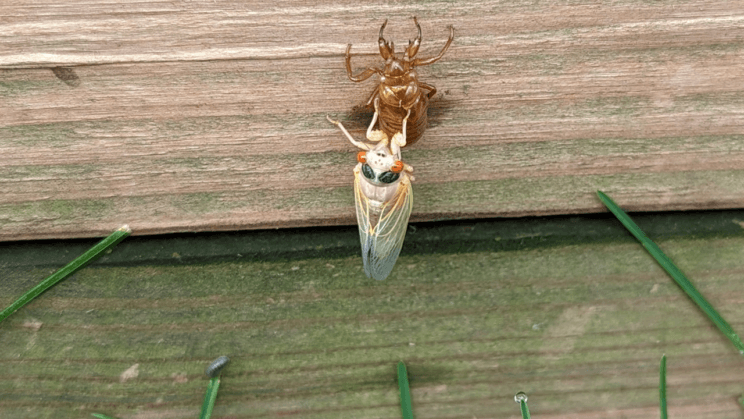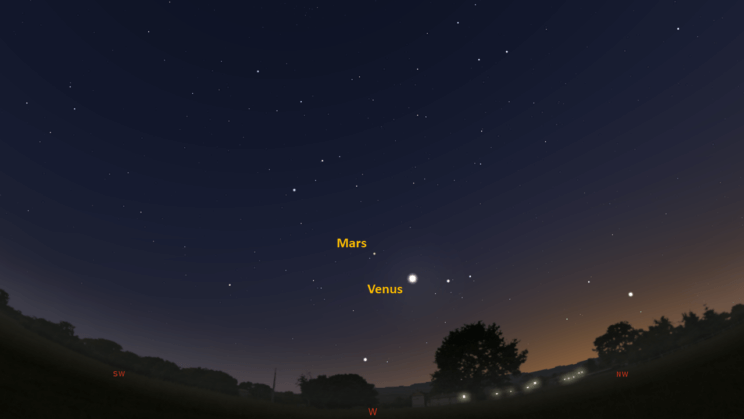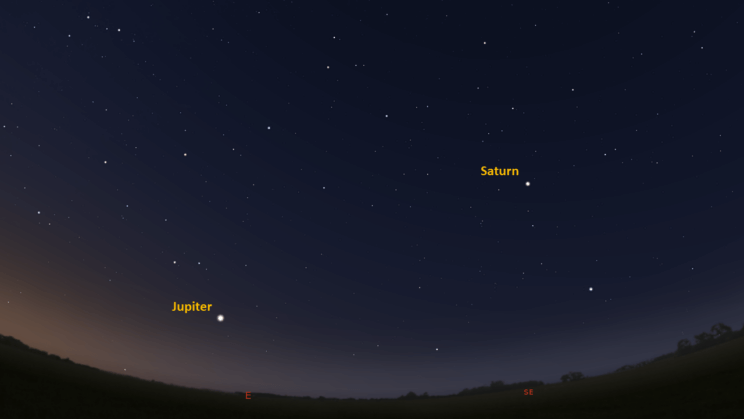This is the Saint Louis Science Center’s NIGHT SKY UPDATE for the week of Friday, June 2, 2023.
Information updated weekly or as needed.
Times given as local St. Louis time which is Central Daylight Time (CDT). For definitions of terminology used in the night sky update, click the highlighted text. If relying on times posted in Universal Time (UT), St. louis is -5 hours when CDT.
Public Telescope Viewings
As part of the Saint Louis Science Center’s First Fridays, weather permitting, the St. Louis Astronomical Society and the Science Center will set up a number of telescopes outdoors and be on-hand to answer your questions. Telescope viewing begins once it is dark. Regardless of the weather on August 4 , join us indoors in our planetarium theater for “The Sky Tonight”. Showtime is at 7 p.m. There is no First Friday event in July.
Observing Highlight of the Week

Cicada having recently molted seen on May 18, 2023. The red eyes on cicadas indicate they are members of one of the periodic broods that emerge on 13 or 17-year cycles. In this case, this cicada is likely an early member of Brood XIX which is the most wide spread 13-year cicada brood. Brood XIX is expected to emerge in Missouri next in 2024. Image credit: Eric Gustafson.
As we approach summer this month, familiar seasonal sights and sounds will return. The songs of tree frogs and toads will soon be joined by the drone of cicadas as they emerge for their final journey to reproduce. Bats are emerging from hibernation to rid our skies of those pesky mosquitos. While the natural world around us is a reminder of the changing season, so are the stars above us. In the east, we can find the precursors of the summer sky shortly after sunset.
The summer sky is one of the best places to start observing if you are new to star gazing. Numerous bright stars, constellations and one of the brightest portions of the Milky Way dominate our summer months. The one downside to summer observing is it does not get dark until after 10:00 p.m. With roughly 15 hours of daylight and another four hours of twilight, we only have about five good hours of darkness to work with.
Summer constellations are a logical place to begin as they are the tool that organizes the sky. Hercules, Scorpius and Lyra will be the first to rise as we transition out of twilight hours. Lyra will be found rising in the northeast and Scorpius will be found in the southeast. Both will be easy to find as they contain the brightest stars visible near the eastern horizon at that time. The white hydrogen fusing dwarf star Vega, is found in Lyra while the red supergiant star Antares is found in Scorpius. Vega will be Earth’s North Star in roughly 12,000 years while Antares is a star likely to go supernova in the future.
As the night continues, Vega will be joined by two other bright stars named Altair and Deneb. Together these three stars form the Summer Triangle. This bright asterism is the best place to start learning about the summer sky. Each bright star in the Triangle is found in different constellations. Vega is in Lyra; Deneb is in Cygnus while Altair is in Aquila. You can find the Triangle and its component constellation fully above the eastern horizon by 11:00 p.m.
In the southeast, Scorpius will continue to rise appearing as a large fishhook-shape of stars. Following Scorpius is Sagittarius which is found by looking for a teapot-shape of stars. Even later, a smile-shape of stars will rise representing the constellation Capricornus. These three are the zodiacal constellations of summer. There are no planets currently in the summer sky but those with larger telescopes will find the dwarf planet Pluto in Capricornus. Pluto appears as 14.36 magnitude object which will require dark skies to have a chance to see.
The summer also offers up several excellent deep sky targets. Several star clusters and nebulae will make for easy binocular targets. Globular clusters Messier 13 and 22 along with the open star clusters Messier 6 and 7 are a good place to begin. M6 and M7 are near the tail of Scorpius, while M13 is in Hercules and M22 is in Sagittarius.
Those traveling to dark skies can look forward to the brightest sections of the Milky Way visible in the northern hemisphere. Between Scorpius and Sagittarius, you can see the bulge of the Milky Way’s center while the Great Rift runs through the Summer Triangle.
Lastly, meteor showers start to pick up again near the end of summer. August offers us one of the best of the year called the Perseids. This meteor shower is active from July 14 to September 1, peaking on August 12-13, 2023. The Perseids usually have a ZHR of 100 meteors per hour making it one of the most consistently active meteor showers each year. The Perseids are favored this year as they peak when the Moon will be in a waning crescent phase with roughly 10% disk illumination.
The Sun and Moon

The Moon as seen from the International Space Station, on July 31, 2011.
Credit: NASA
Sunrise is at 5:38 a.m. on Friday, June 2 and sunset is at 8:20 p.m. providing us with nearly 15 hours of daylight. Even after sunset, light from the Sun will dimly illuminate our sky for nearly 2 hours. This period is called twilight, which ends around 10:15 p.m. this week. For those with a sundial, local noon occurs around 12:58 p.m. this week.
| Day | Sunrise | Sunset | ||||||||||
|---|---|---|---|---|---|---|---|---|---|---|---|---|
| 2-Jun | 5:38 a.m. | 8:20 p.m. | ||||||||||
| 3-Jun | 5:37 a.m. | 8:21 p.m. | ||||||||||
| 4-Jun | 5:37 a.m. | 8:21 p.m. | ||||||||||
| 5-Jun | 5:37 a.m. | 8:22 p.m. | ||||||||||
| 6-Jun | 5:37 a.m. | 8:23 p.m. | ||||||||||
| 7-Jun | 5:36 a.m. | 8:23 p.m. | ||||||||||
| 8-Jun | 5:36 a.m. | 8:24 p.m. | ||||||||||
| 9-Jun | 5:36 a.m. | 8:24 p.m. | ||||||||||
| 10-Jun | 5:36 a.m. | 8:25 p.m. |
Moon
Moonrise for Friday, June 2 is at 7:08 p.m. and moonset occurs at 4:54 a.m. on the following day. On Friday, June 2, the Moon will exhibit a waxing gibbous phase with 98% disk illumination. Last quarter moon occurs on June 10, 2023, at 2:31 p.m.
International Space Station (ISS) Observing

There is one visible pass of ISS from St. Louis for the week of June 2. Use the table below for information about this pass. ISS will return to St. Louis skies on June 22, 2023. While we wait for ISS to return, you can find numerous satellites passing overhead each night. A good place to learn about these is https://heavens-above.com. If you are not from the St. Louis area, make sure to set your observing location.
Catch ISS from St. Louis starting Friday, June 2
| Date | Starts | Max. altitude | Ends | |||||||
|---|---|---|---|---|---|---|---|---|---|---|
| Time | Alt. | Az. | Time | Alt. | Az. | Time | Alt. | Az. | ||
| 02 Jun | -1.8 | 21:10:24 | 10 | W | 21:13:01 | 21 | SW | 21:15:36 | 10 | S |
Magnitude (Mag): The Measure of brightness for a celestial object. The lower the value is, the brighter the object will be.
Altitude (Alt): The angle of a celestial object measured upwards from the observer’s horizon.
Azimuth (Az): The direction of a celestial object, measured clockwise from an observer’s location with north being 0°, east being 90°, south being 180° and west being 270°.
For information about ISS flyovers and other visible satellites, visit www.heavens-above.com
Detailed information regarding all unmanned exploration of our universe, missions past, present, and planned, can be found at Jet Propulsion Laboratories:
The Visible Planets

Looking west at 9:15 p.m. on June 4, 2023. Credit: Stellarium, EG

Looking Southeast at 4:38 a.m. on June 5, 2023. Credit: Stellarium, EG
This week, four naked eye planets will be visible. Venus and Mars are found in the west after sunset. Saturn and Jupiter are visible in the southeast and east before sunrise.
Venus
Venus is well into its current evening apparition. Venus will be a bright target in the west after sunset until August 2023 when it approaches inferior conjunction. This week, look for Venus in the west about 20 minutes after sunset. Venus sets at 11:34 p.m.
Mars
Mars now rises before sunset, becoming visible once it is dark. Look for it high in the west about 30 minutes after sunset. Mars sets at 11:59 a.m.
Jupiter
Jupiter is starting another apparition. Jupiter rises at 3:37 a.m. The giant world will be roughly 11° above the eastern horizon by 4:37 a.m. Jupiter will rise about 25 minutes earlier each week.
Saturn
Saturn rises at 1:18 a.m. Start looking for Saturn about 30 minutes after it rises. If you have lots of trees or buildings, you may have to wait an hour or so after it rises before it will be visible.
James S. McDonnell Planetarium
Night Sky Update: June 2-10, 2023






